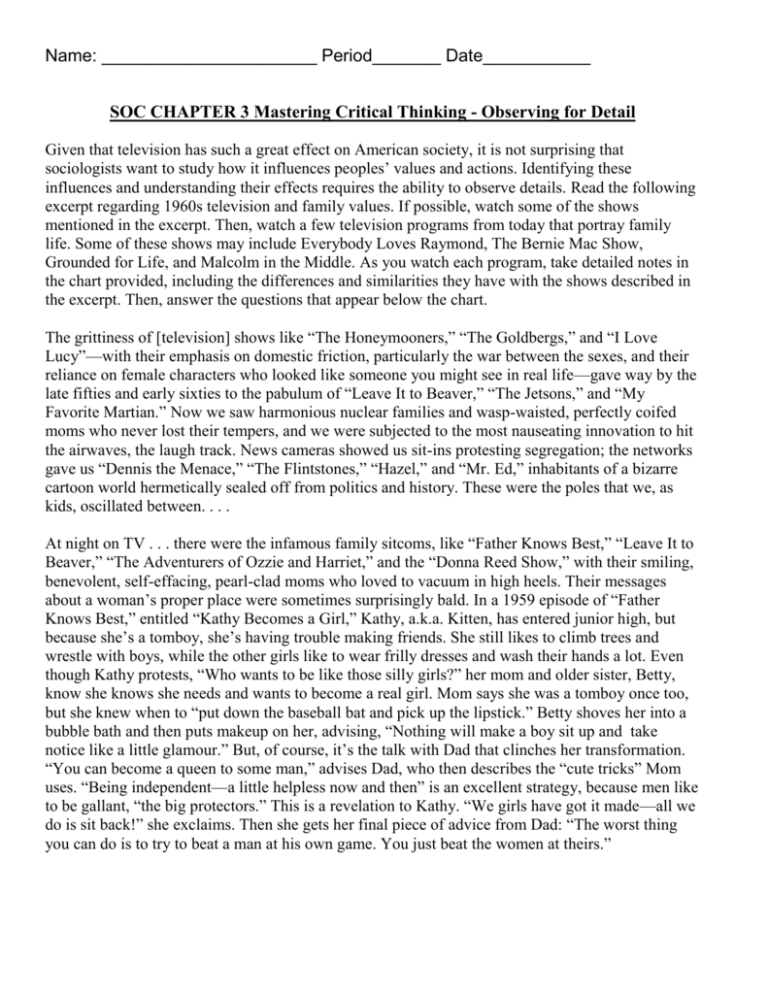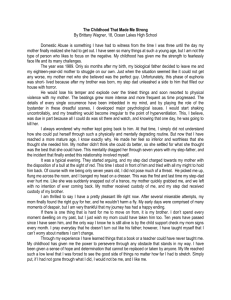SOC CHAPTER 3 Mastering Critical Thinking
advertisement

Name: ______________________ Period_______ Date___________ SOC CHAPTER 3 Mastering Critical Thinking - Observing for Detail Given that television has such a great effect on American society, it is not surprising that sociologists want to study how it influences peoples’ values and actions. Identifying these influences and understanding their effects requires the ability to observe details. Read the following excerpt regarding 1960s television and family values. If possible, watch some of the shows mentioned in the excerpt. Then, watch a few television programs from today that portray family life. Some of these shows may include Everybody Loves Raymond, The Bernie Mac Show, Grounded for Life, and Malcolm in the Middle. As you watch each program, take detailed notes in the chart provided, including the differences and similarities they have with the shows described in the excerpt. Then, answer the questions that appear below the chart. The grittiness of [television] shows like “The Honeymooners,” “The Goldbergs,” and “I Love Lucy”—with their emphasis on domestic friction, particularly the war between the sexes, and their reliance on female characters who looked like someone you might see in real life—gave way by the late fifties and early sixties to the pabulum of “Leave It to Beaver,” “The Jetsons,” and “My Favorite Martian.” Now we saw harmonious nuclear families and wasp-waisted, perfectly coifed moms who never lost their tempers, and we were subjected to the most nauseating innovation to hit the airwaves, the laugh track. News cameras showed us sit-ins protesting segregation; the networks gave us “Dennis the Menace,” “The Flintstones,” “Hazel,” and “Mr. Ed,” inhabitants of a bizarre cartoon world hermetically sealed off from politics and history. These were the poles that we, as kids, oscillated between. . . . At night on TV . . . there were the infamous family sitcoms, like “Father Knows Best,” “Leave It to Beaver,” “The Adventurers of Ozzie and Harriet,” and the “Donna Reed Show,” with their smiling, benevolent, self-effacing, pearl-clad moms who loved to vacuum in high heels. Their messages about a woman’s proper place were sometimes surprisingly bald. In a 1959 episode of “Father Knows Best,” entitled “Kathy Becomes a Girl,” Kathy, a.k.a. Kitten, has entered junior high, but because she’s a tomboy, she’s having trouble making friends. She still likes to climb trees and wrestle with boys, while the other girls like to wear frilly dresses and wash their hands a lot. Even though Kathy protests, “Who wants to be like those silly girls?” her mom and older sister, Betty, know she knows she needs and wants to become a real girl. Mom says she was a tomboy once too, but she knew when to “put down the baseball bat and pick up the lipstick.” Betty shoves her into a bubble bath and then puts makeup on her, advising, “Nothing will make a boy sit up and take notice like a little glamour.” But, of course, it’s the talk with Dad that clinches her transformation. “You can become a queen to some man,” advises Dad, who then describes the “cute tricks” Mom uses. “Being independent—a little helpless now and then” is an excellent strategy, because men like to be gallant, “the big protectors.” This is a revelation to Kathy. “We girls have got it made—all we do is sit back!” she exclaims. Then she gets her final piece of advice from Dad: “The worst thing you can do is to try to beat a man at his own game. You just beat the women at theirs.” Name: ______________________ Period_______ Date___________









